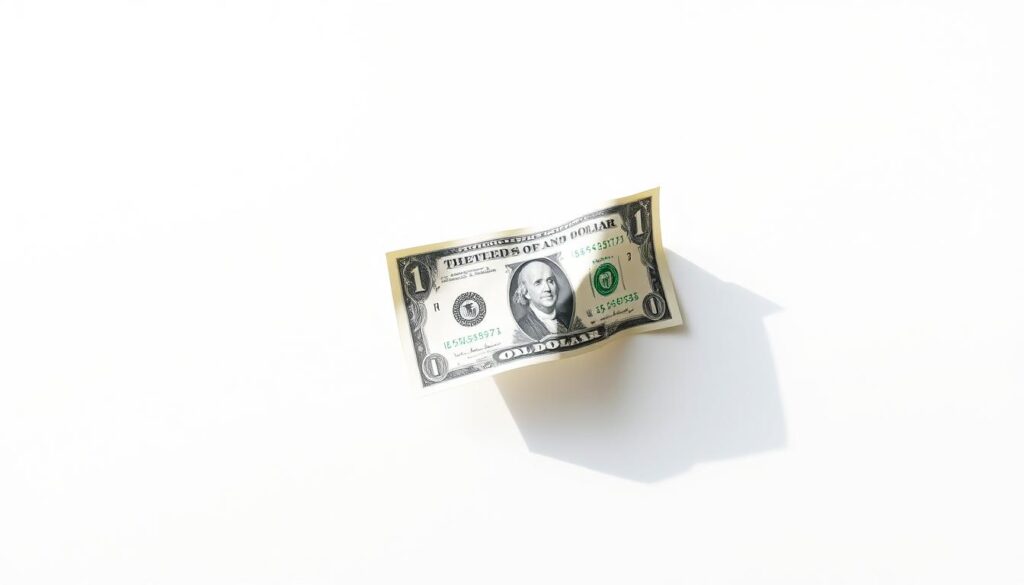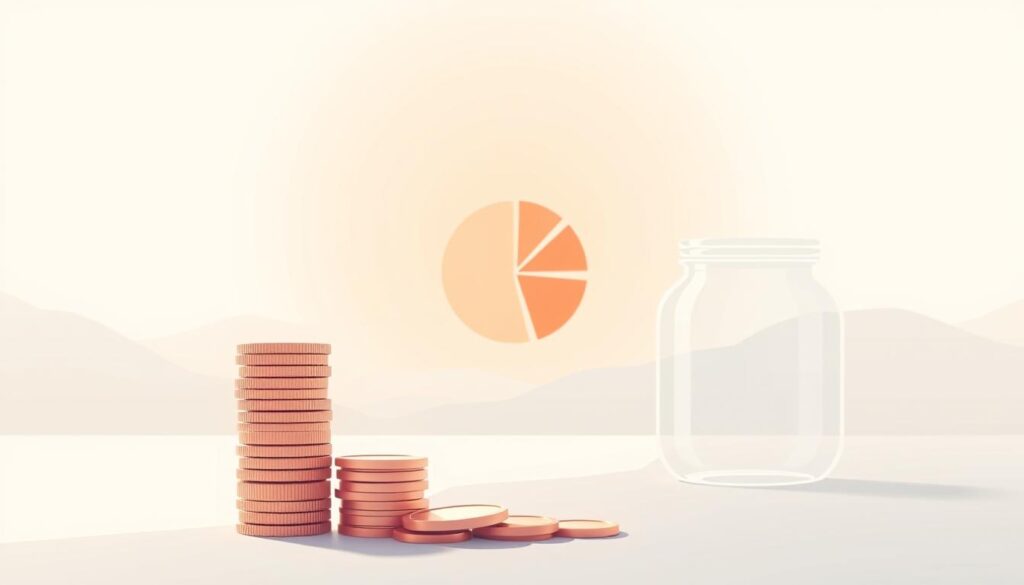
Can saving just one dollar a day really make a difference in your financial situation? The answer may surprise you. The $1 challenge is a simple yet powerful money-saving challenge. It can help you build wealth over time.
By incorporating micro-saving strategies into your daily routine, you can make significant progress towards your financial goals. The $1 challenge is an easy and accessible way to get started with saving. It’s a great way to develop healthy financial habits.
The concept of micro-saving is based on the idea that small, consistent savings can add up to make a big difference. By saving just one dollar a day, you can save over $350 in a year. This may not seem like a lot, but it’s a great starting point for building wealth.
The key is to make saving a habit and to be consistent. With the $1 challenge, you can start small and work your way up to bigger savings goals. This money-saving challenge is a great way to get started with saving tips and to develop a savings mindset.
Key Takeaways
- The $1 challenge is a simple and accessible way to get started with saving
- Micro-saving strategies can help you build wealth over time
- Saving just one dollar a day can add up to make a big difference
- Consistency is key when it comes to saving
- The $1 challenge is a great way to develop healthy financial habits
- This money-saving challenge can help you save over $350 in a year
Understanding the Power of Micro-Saving
Micro-saving strategies are a great way to start building wealth. It’s key to understand the psychology behind small savings. Saving a small amount each day can lead to big financial gains over time.
The concept of micro-saving is simple. Small, consistent savings can make a big difference in your finances. It’s all about making saving a habit.
To succeed in micro-saving, make it a part of your daily routine. Saving a little each day, like one dollar, is a simple yet effective way to start. This approach helps you overcome the challenge of starting to save.
- Developing a savings mindset
- Building discipline and consistency
- Reducing financial stress
- Increasing wealth over time
By following these tips and incorporating micro-saving into your life, you can start achieving your financial goals. It’s a step towards overcoming the challenge of saving.
Getting Started with The $1 Challenge: Micro-Saving Strategies That Actually Add Up

To start the $1 challenge, you need to set financial goals and make a savings plan. Look for ways to cut back on things you don’t need. This way, you can save that money for the small savings challenge.
Here are some money-saving tips to help you get started:
- Track your daily expenses to understand where your money is going
- Set up a separate savings account for the $1 challenge
- Choose a savings method that works for you, such as automatic transfers or manual deposits
Success in the $1 challenge comes from making it a daily habit. Saving a little each day can quickly add up. Keep track of your progress and celebrate your achievements. With the right mindset and budgeting methods, you can reach your financial goals.
Remember, every dollar matters in the $1 challenge. It’s a great way to build good financial habits. Follow these money-saving tips and stay committed. You’ll be on your way to financial stability and success.
Digital Tools and Apps for Dollar-Based Saving
Using digital tools and apps can make your $1 challenge easier. They help you track your progress and save money. With these tools, you can set up automatic transfers and focus on saving.
Apps like Qapital, Digit, and Acorns are great for saving money. They let you set goals, track your progress, and get reminders. These apps help you build good money habits and save more.
When picking an app for automatic transfers, choose one that fits your goals. Here are some options:
- Qapital: Offers various savings rules and goals to help you reach financial wellness
- Digit: Looks at your spending and moves small amounts to your savings
- Acorns: Invests your spare change in a diversified portfolio, growing your savings
Digital tools and apps can elevate your $1 challenge. They make saving easier and help you achieve financial wellness. Try out different apps to find the best fit for you.
“Enhance your $1 Challenge with smart saving tools! Explore apps like Qapital, Digit, or Acorns to automate your savings, track your progress, and stay motivated on your journey to financial success.”
Creative Ways to Find Your Daily Dollar
Finding an extra dollar a day can seem like a big challenge. But, with the right budgeting, it’s doable. Start by cutting back on things you don’t need or finding better deals on bills.
Selling things you no longer use is another smart move. You can list items online, have a garage sale, or sell them at consignment shops. This way, you declutter and make some extra cash for savings.
Some folks earn extra by taking on small jobs. This could be freelancing, pet-sitting, or doing online surveys. These jobs are quick and easy, adding to your daily savings.
Using budgeting rules like the 50/30/20 can also help. It means 50% for needs, 30% for wants, and 20% for savings. This rule helps you save and pay off debt while still enjoying life.
Being creative and flexible is key to finding your daily dollar. Try different saving strategies and budgeting methods. This way, you can find a plan that fits your life and helps you reach your financial goals.
Imagine financing your dreams without banks. Peer-to-peer lending makes this possible. It lets strangers help fund your projects. This way, you can turn your ideas into reality. read more about it from here – Crowdfunded Loans: How Strangers Can Finance Your Dreams
Building Better Money Habits Through Micro-Saving

Building a strong financial base needs the right mindset and smart saving tips. Focusing on financial health helps create lasting habits. Micro-saving is a great start, as it lets people save a little bit regularly.
To succeed with micro-saving, setting realistic targets is key. Use digital tools or apps to track your savings. This way, saving becomes a part of your daily routine, helping you beat common hurdles like lack of motivation or unexpected costs.
- Make a budget that includes regular savings
- Automate savings to avoid forgetting
- Keep an eye on your savings and tweak your plan if needed
Stick to these tips and stay consistent. This will help you build a strong saving habit. You’ll reach your financial goals, leading to better financial health and a secure future.
Leveraging Your Saved Dollars
After you finish the money-saving challenge, it’s key to have a plan for your savings. There are many personal finance tips to help you use your money wisely. One smart move is to put your savings in a high-yield savings account. This type of account often has a higher interest rate than regular savings accounts.
Another smart choice is to use your savings to pay off debts. This could be credit card balances or loans with high interest rates. This way, you save money on interest and have more for future savings. Investing your savings is also a good option, as it can grow your money over time. But, make sure to think about your financial goals and how much risk you can handle before investing.
Some important things to think about when using your saved dollars include:
- Assessing your financial goals and risk tolerance
- Exploring different savings accounts and investment options
- Creating a budget and tracking your expenses
- Automating your savings and investments
By using these saving strategies and considering your personal finance tips, you can maximize your savings. Always keep your savings in line with your financial goals. Adjust your plan as needed to stay on track.
Real Success Stories from $1 Challenge Participants
Many people have joined the $1 challenge and saved a lot of money. They used smart money-saving tips to reach their goals. By saving a little each day, they made a big difference in their finances.
Some have saved over $300 in a few months. This might seem small to some, but it’s huge for others. Success comes from being consistent and patient, and finding strategies that work for you.
People have talked about how tracking their progress and staying motivated helped. Setting realistic goals and celebrating milestones are key. These steps help keep you focused and make your savings efforts worthwhile.
Some notable achievements include:
- Reaching monthly milestones, such as saving $30 in 30 days
- Developing sustainable financial habits, like automatic transfers and budgeting
- Learning valuable lessons about the power of micro-saving and its impact on overall financial well-being
These stories show how the $1 challenge can really change your finances. By using micro-saving strategies and sticking to the challenge, you can save a lot and get financially stable.
Combining the $1 Challenge with Other Saving Strategies
Reaching personal finance goals requires a mix of strategies. Starting with the $1 challenge is a good first step. But adding other saving strategies can boost your financial wellness. The 50/30/20 rule is a great example. It suggests using 50% for needs, 30% for wants, and 20% for saving and paying off debt.
Creating a savings ladder is another smart move. It helps you set and reach both short and long-term savings goals. Also, using employer-matched retirement accounts can significantly increase your savings. Combining these methods with the $1 challenge can lead to better savings and financial health.
Some key benefits of mixing the $1 challenge with other savings plans include:
- More savings over time
- Better financial discipline
- Improved financial health
By adding these saving strategies to your daily life, you’re on your way to reaching your personal finance goals. Remember, every dollar matters. Using the $1 challenge with other practical savings techniques can maximize your financial gains.
Conclusion: Making Every Dollar Count
The $1 Challenge is a great way to save money. By saving just one dollar a day, you’ll see how much you can save over time. This is thanks to the power of compound interest.
This challenge helps you save for emergencies, big purchases, or just to get better at managing money. Digital tools make it easy to track your savings and move money around automatically.
Every dollar you save matters, and starting small can lead to big savings. Take on the $1 Challenge and start your journey to financial security. It all begins with that first dollar. So, what are you waiting for?
The $1 Challenge : FAQ
What is the $1 challenge?
The $1 challenge is a simple way to save money. You save just $1 each day. This small amount can add up over time, helping you build a financial safety net.
Why is the $1 challenge effective?
It’s easy to start saving $1 a day. This goal is doable, even with a tight budget. Plus, your savings grow thanks to compound interest. It also helps you develop good money habits.
How do I get started with the $1 challenge?
Start by opening a savings account or using a savings app. Plan to save $1 every day. You can do this manually or set up automatic transfers. Keeping track of your savings can keep you motivated.
What are some creative ways to find an extra dollar a day?
Look for ways to cut small daily expenses. Try bringing your lunch or skipping coffee. You can also sell items you no longer need or take on a side job. Find what works best for you.
How can I combine the $1 challenge with other saving strategies?
You can mix the $1 challenge with other saving plans. Try the 50/30/20 rule or a savings ladder. Using employer-matched retirement accounts can also help. A multi-strategy approach can boost your savings.
What are some of the long-term benefits of the $1 challenge?
Saving $1 a day can lead to big benefits over time. Your savings can grow into a large emergency fund or a down payment on a home. It can also secure your retirement. Plus, it helps you save better and think more about money.







